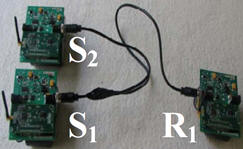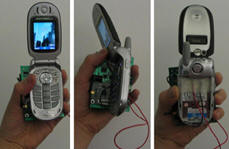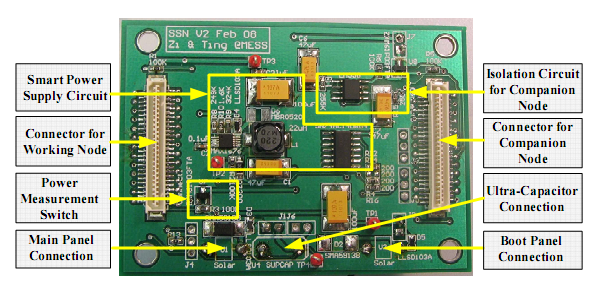


|
|
|
 |

|

This work is aiming at building sustainable sensor networks for long-term applications in energy-dynamic environments. The driven idea of this project is energy-synchronized computing — a holistic and systematic approach to synchronize sensor network activities with dynamic energy supply from the environments. The expected deliveries of this project are (i) the hardware design and implementation of energy-efficient nodes, (ii) the architecture principles, theoretical insights, design methodologies, and protocols for Sustainable Sensor Networks, (iii) the running prototype systems for long-term sustainable applications, and (iv) the educational test-beds, outreach activities for K-12 students and minority groups, and curriculum designs for undergraduate and graduate courses

|
Tian He
Contribution to the Project: The PI contributes to this project by (i) developing algorithms, protocols, systems and underlying theoretical foundations for sustainable sensor networks, (ii) provide guidance on the design of Twinstar hardware, (iii) advising PhD students on how to address related research problems, (iv) writing technical reports and papers, (v) collaborating with domain experts for broader impact, (vi) heavily involving in the sensor network community for the visibility of this work, (vii) preparing outreach programs (e.g., open houses) for a diverse group of individual k-12 students and visitors, (viii) giving seminars and talks and preparing a website to disseminate the related research results, and (ix) developing new courses |
|
Shi Bai Contribution to the Project: On energy efficent design for sensor networks. He focuses mostly in theory |
|
Song Min Contribution to the Project: design and implementation support for sustainable networks. |
|
Desheng
Zhang Contribution to the Project: on the low-power communication protocol design and implementation |
|
Shuai Wang Contribution to the Project: on the low-power communication protocol design and implementation |
|
Ziguo Zhong
(Gradated) Contribution to the Project: energy efficient designs for mobile sustainable sensor networks. |
|
Shuo
Guo (Gradated) Contribution to the Project: energy efficient designs for mobile sustainable sensor networks. |
|
Yongle Cao
(Gradated) Contribution to the Project: on the low-power communication protocol design and implementation |
|
Yu
GU (Gradated) Contribution to the Project: energy efficient designs for mobile sustainable sensor networks. |
|
Ting Zhu (Gradated) Contribution to the Project: on the low-power communication protocol design and implementation |

|
Jacob Grimes, Senior Undergraduate Student Contribution to the Project: Visualization tasks (ongoing) |
|
Umayah Abdennabi, Senior Undergraduate Students. Contribution to the Project: Visualization tasks (ongoing) |

  |
eShare supports the concept of energy sharing among multiple devices by providing designs for energy routers (i.e., energy storage and routing devices) and related energy access and network protocols. In a nutshell, energy routers exchange energy sharing control information using their data network while sharing energy freely among connected devices using their energy network. We extensively evaluate our system under six real-world settings and the result has been reported in ACM SenSys 2010 [PDF]. |
 |
|
|
 is
a large indoor sensor network test-bed,
supporting up to 360 nodes. The whole test-bed is composed of six 4 feet
by 8 feet boards. Each board in the system can be used as an individual
sub-system, because each board is designed to be separately powered,
separately controlled and separately metered. Each individual
board can support up to 60 nodes, therefore, the whole system can
support up to 360 nodes working simultaneously. In the first phase of
construction, three high-end HIT HITCPX1250 projectors are used to
generate event (it is capable to create mirage ). In the
second phase of construction, motorize objects are introduced to
create another sets of mobile targets. The ultimate goal of this testbed
is to allow researchers to conduct all kinds of system research locally
and remotely with realistic sensing modality as inputs. The first
phase of construction is finished during 2007. In the second phase,
mobility support will be added. is
a large indoor sensor network test-bed,
supporting up to 360 nodes. The whole test-bed is composed of six 4 feet
by 8 feet boards. Each board in the system can be used as an individual
sub-system, because each board is designed to be separately powered,
separately controlled and separately metered. Each individual
board can support up to 60 nodes, therefore, the whole system can
support up to 360 nodes working simultaneously. In the first phase of
construction, three high-end HIT HITCPX1250 projectors are used to
generate event (it is capable to create mirage ). In the
second phase of construction, motorize objects are introduced to
create another sets of mobile targets. The ultimate goal of this testbed
is to allow researchers to conduct all kinds of system research locally
and remotely with realistic sensing modality as inputs. The first
phase of construction is finished during 2007. In the second phase,
mobility support will be added. |

This material is presented to ensure timely dissemination of scholarly and technical work. Copyright and all rights therein are retained by authors or by other copyright holders.
Desheng Zhang and Tian He and Yunhuai Liu and Yu Gu and Fan Ye and Raghu k. Ganti and Hui Lei. (2012). Acc: Generic On-Demand Accelerations for Neighbor Discovery in Mobile Applications. SenSys '12: Proceedings of the 10th international conference on Embedded networked sensor systems. . Status = PUBLISHED; Acknowledgement of Federal Support = Yes
Yu Gu and Tian He (2010). Bounding Communication Delay in Energy Harvesting Sensor Networks. The 30th International Conference on Distributed Computing Systems. . Status = PUBLISHED; Acknowledgement of Federal Support = Yes
Jia Li and Sogn Min Kim and Tian He (2014). Circular Pipelining: Minimizing Round-Trip Delay in Low-Duty-Cycle Wireless Networks. The 22th IEEE International Conference on Network Protocols(ICNP '14). . Status = PUBLISHED; Acknowledgement of Federal Support = Yes
Qingquan Zhang and Yu Gu and Lin Gu and Qing Cao and Tian He (2011). Collaborative Scheduling in Highly Dynamic Environments Using Error Inference. MSN 2011. . Status = PUBLISHED; Acknowledgement of Federal Support = Yes
Long Cheng and Yu Gu and Tian He and Jianwei Niu (2013). Dynamic switching-based reliable flooding in low-duty-cycle wireless sensor networks. INFOCOM. . Status = PUBLISHED; Acknowledgement of Federal Support = Yes
Desheng Zhang and Tian He and Fan Ye and Raghu Ganti and Hui Lei. (2012). EQS:Neighbor Discovery and Rendezvous Maintenance with Extended Quorum System forMobile Sensing Applications. 32th IEEE International Conference on Distributed Computing Systems (ICDCS '12). . Status = PUBLISHED; Acknowledgement of Federal Support = Yes
Yu Gu and Ting Zhu and Tian He (2009). ESC: Energy Synchronized Communication in Sustainable Sensor Networks. The 17th International Conference on Network Protocols (ICNP '09). . Status = PUBLISHED; Acknowledgement of Federal Support = Yes
Ting Zhu and Ziguo Zhong and Tian He and Zhi-Li Zhang (2010). Exploring Link Correlation for Efficient Flooding in Wireless Sensor Networks . 7th USENIX Symposium on Networked Systems Design and Implementation (NSDI '10). . Status = PUBLISHED; Acknowledgement of Federal Support = Yes
Liangyin Chen and Yu Gu and Shuo Guo and Tian He and Yuanchao Shu and Fan Zhang and Jiming Chen (2012). Group-based Discovery in Low-Duty-Cycle Mobile Sensor Networks. The 9th Annual IEEE Communications Society Conference on sensor, Mesh and Ad Hoc Communications and Networks. . Status = PUBLISHED; Acknowledgement of Federal Support = Yes
Ting Zhu and Ziguo Zhong and Yu Gu and Tian He and Zhi-Li Zhang (2009). Leakage-Aware Energy Synchronization for Wireless Sensor Networks. The 7th Annual International Conference on Mobile Systems, Applications and Services (MobiSys '09). . Status = PUBLISHED; Acknowledgement of Federal Support = Yes
Yuanchao Shu and Peng Cheng and Yu Gu and Jiming Chen and Tian He (2014). Minimizing Communication Delay in RFID-based Wireless Rechargeable Sensor Networks. International Conference on Sensing, Communicaiton, and Networking. . Status = PUBLISHED; Acknowledgement of Federal Support = Yes
Lingkun Fu and Peng Cheng and Yu Gu and Jiming Chen and Tian He (2013). Minimizing charging delay in wireless rechargeable sensor networks. INFOCOM. . Status = PUBLISHED; Acknowledgement of Federal Support = Yes
Jiming Chen and Junkun Li and Shibo He and Tian He and Yu Gu and Youxian Sun (2011). On Energy-Efficient Trap Coverage in Wireless Sensor Networks. In The 32th IEEE Real-Time Systems Symposium. . Status = PUBLISHED; Acknowledgement of Federal Support = Yes
Ziguo Zhong and Pengpeng Chen and Tian He (2011). On-Demand Time Synchronization with Predictable Accuracy. IEEE INFOCOM '11. . Status = PUBLISHED; Acknowledgement of Federal Support = Yes
Shuo Guo and Yu Gu and Bo Jiang and Tian He (2009). Opportunistic Flooding in Low-Duty-Cycle Wireless Sensor Networks with Unreliable Links. The 15th Annual International Conference on Mobile Computing and Networking (MobiCom), 2009 . . Status = PUBLISHED; Acknowledgement of Federal Support = Yes
Hao Huang and Jihoon Yun and Ziguo Zhong and Song Min Kim and Tian He (2013). PSR: Practical synchronous rendezvous in low-duty-cycle wireless networks. INFOCOM. . Status = PUBLISHED; Acknowledgement of Federal Support = Yes
Liang He and Yu Gu and Tian He (2012). Poster Abstract:Energy Synchronized Charging in Sensor Networks. 10th ACM Conference on Embedded Networked Sensor Systems (SenSys 2012) . . Status = PUBLISHED; Acknowledgement of Federal Support = Yes
Liang He and Linghe Kong and Siyu Lin and Shaodong Ying and Yu Gu and Tian He and Cong Liu (2014). Reconfiguration-Assisted Charging in Large-Scale Lithium-ion Battery Systems. he 5th ACM/IEEE International Conference on Cyber-Physical Systems (ACM/IEEE ICCPS'14). . Status = PUBLISHED; Acknowledgement of Federal Support = Yes
Yongle Cao and Shuo Guo and Tian He (2012). Robust Multi-Pipeline Scheduling in Low-Duty-Cycle Wireless Sensor Networks. IEEE INFOCOM '12. . Status = PUBLISHED; Acknowledgement of Federal Support = Yes
Haipeng Dai and Yunhuai Liu and Guihai Chen and Xiaobing Wu and Tian He (2014). SCAPE: Safe Charging with Adjustable PowEr. 34th IEEE International Conference on Distributed Computing Systems (ICDCS '14). . Status = PUBLISHED; Acknowledgement of Federal Support = Yes
Haipeng Dai and Yunhuai Liu and Guihai Chen and Xiaobing Wu and Tian He (2014). Safe Charging for Wireless Power Transfer. IEEE INFOCOM '14. . Status = PUBLISHED; Acknowledgement of Federal Support = Yes
Yongle Cao and Ziguo Zhong and Yu Gu and Tian He (2011). Safeguarding Schedule Updates in Wireless Sensor Networks. IEEE INFOCOM '11 Mini-Conference. . Status = PUBLISHED; Acknowledgement of Federal Support = Yes
Yu Gu and Tian He and Mingen Lin and Jinhui Xu (2009). Spatiotemporal Delay Control for Low-Duty-Cycle Sensor Networks. In The 30th IEEE Real-Time Systems Symposium. . Status = PUBLISHED; Acknowledgement of Federal Support = Yes
Shi Bai and Tian He (2013). Throughput Optimization in Energy Sharing Wireless Sensor Networks. In the 10th IEEE International Conference on Mobile Ad-hoc and Sensor Systems. . Status = PUBLISHED; Acknowledgement of Federal Support = Yes
Ting Zhu and Yu Gu and Tian He and Zhi-Li Zhang (2010). eShare: A Capacitor-Driven Energy Storage and Sharing Network for Long-Term Operation. SenSys '10: Proceedings of the 8th international conference on Embedded networked sensor systems. . Status = PUBLISHED; Acknowledgement of Federal Support =
John A. Stankovic and Tian He (2011). Energy Management (Chapter). Philosophical Transactions of the Royal Society. . Status = PUBLISHED; Acknowledgment of Federal Support = Yes
Lingkun Fu and Peng Cheng and Yu Gu and Jiming Chen and Tian He (2015). The Optimal Charging in Wireless Rechargeable Sensor Networks. IEEE Transactions on Vehicular Technology. . Status = PUBLISHED; Acknowledgment of Federal Support = Yes
Qingquan Zhang and Lingkun Fu and Yu Gu and Lin Gu and Qing Cao and Jiming Chen and Tian He (2013). Collaborative Scheduling in Dynamic Environments Using Error Inference. IEEE Transactions on Parallel and Distributed Systems (to appear). . Status = PUBLISHED; Acknowledgment of Federal Support = Yes
Shibo He and Jiming Chen and Peng Cheng and Yu Gu and Tian He and Youxian Sun (2012). Maintaining Quality of Sensing with Actors in Wireless Sensor Networks. In IEEE Transactions on Parallel and Distributed Systems, Special issue-Cyber Physical Systems. 23 (9), 1657-1667. Status = PUBLISHED; Acknowledgment of Federal Support = Yes
Shuai Wang and Song Min Kim and Yunhuai Liu and Guang Tan and Tian He (2014). CorLayer: A Transparent Link Correlation Layer for Energy Efficient Broadcasts. IEEE/ACM Transactions on Networking (TON). . Status = PUBLISHED; Acknowledgment of Federal Support = Yes
Shuo Guo and Liang He and Yu Gu and Bo Jiang and Tian He (2013). Opportunistic Flooding in Low-Duty-Cycle Wireless Sensor Networks with Unreliable Links. IEEE Transactions on Computers. 99 (PrePrints), 1. Status = PUBLISHED; Acknowledgment of Federal Support = Yes ; DOI: http://doi.ieeecomputersociety.org/10.1109/TC.2013.142
Ting Zhu and Ziguo Zhong and Tian He and Zhi-Li Zhang (2013). Energy-synchronized computing for sustainable sensor networks. Ad Hoc Networks. 11 (4), 1392-1404. Status = PUBLISHED; Acknowledgment of Federal Support = Yes
Ting Zhu and Yu Gu and Tian He and Zhi-Li Zhang (2012). Achieving Long-Term Operation with a Capacitor-Driven Energy Storage and Sharing Network. ACM Transactions on Sensor Networks (TOSN), . 8 (4), 32. Status = PUBLISHED; Acknowledgment of Federal Support = Yes
Ting Zhu and Ziguo Zhong and Tian He and Zhi-Li Zhang (2010). Energy-Synchronized Computing for Sustainable Sensor Networks. Elsevier Ad Hoc Networks Journal. . Status = PUBLISHED; Acknowledgment of Federal Support = Yes
Ting Zhu and Ziguo Zhong and Yu Gu and Tian He and Zhi-Li Zhang (2010). Feedback Control-based Energy Management for Ubiqitous Sensor Networks. IEICE Transactions on Communications, Special section on Fundamental Issues on Deployment of Ubiquitous Sensor Networks. . Status = PUBLISHED; Acknowledgment of Federal Support = Yes
Yu Gu and Liang He and Ting Zhu and Tian He (2013). Achieving Energy Synchronized Communication in Energy-Harvesting Wireless Sensor Networks. ACM Transaction on Embedded Computing System. . Status = PUBLISHED; Acknowledgment of Federal Support = Yes
Yu Gu and Long Cheng and Jianwei Niu and Tian He and David H.C Du (2013). Achieving Asymmetric Sensing Coverage for Duty Cycled Wireless Sensor Networks. IEEE Transactions on Parallel and Distributed Systems. . Status = PUBLISHED; Acknowledgment of Federal Support = Yes
Yu Gu and Tian He (2011). Dynamic Switching-Based Data Forwarding for Low-Duty-Cycle Wireless Sensor Networks. IEEE Transactions on Mobile Computing. 10 (12), 1741 -1754. Status = PUBLISHED; Acknowledgment of Federal Support = Yes ; DOI: 10.1109/TMC.2010.266

PhD. Mentoring: The grant has benefited the human resource development significantly. Six of my PhD students have successfully landed tenure-track assistant professor positions (first employment) in reputable universities during last five years. (i) Ziguo Zhuo has joined The University of Nebraska-Lincoln in 2011; (ii) Yu Gu has joined Singapore Universityof Technology in 2010, (iii) Chi-Yin Chow has joined the City University of Hong Kong in 2010, (iv) Ting Zhu has joined the University of New York at Binghamton in 2011, , (v) Jaehoon Paul Jeong has joined Sungkyunkwan University (fourth ranked), South Korea in 2012, and (vi) Andy Peng has joined University of Wisconsin – Stout in 2014. All of them have been working on related topics during their PhD. I also graduate a female PhD who is partially supported by this grant. She is now working in Arista Networks, a recent IPO company in 2014.
Master Mentoring: I also trained a few master students and teach them to program Tinyos and finish a few independent projects. They participate in Nokia grand challenge for wireless innovation and my group won Distinguished Nokia Sensing X-CHALLENGE Award, 2014. We have built a 360-node mirage testbed, which has been used for course projects.
Developing New Courses: I have developed two new courses, a graduate-level course on wireless sensor networks (CS8221) and an undergraduate-level course on wireless ad hoc networks (CS5231). In both course, the concept of sustainable energy aware networks has been introduced. I also participate the open house and K-12 outreach in Minnesota. Middle-schoolers have been engaged via open houses hosted annually to use our test-beds to interest them in technology in general and engineering in particular. We demonstrated to the visitors the Twinstar and eShare hardware we build and the applications that run on the Mirage Testbed.

Interdisciplinary Collaboration: We are currently collaborating with the department of transportation, the Technology-Enhanced Learning Council, and the National Center for Earth Surface Dynamics for applying sustainable networks in traffic management, technology-enhanced learning, and ecosystem exploration. This grant also gives us the opportunity to conduct interdisciplinary research with scientist outside of engineering field. Recently I worked with domain scientist such as Prof. Nick Teresa in the department of Neuroscience, University of Minnesota to apply sustainable networking to collection bio-information.
K-12 Outreach: The outreach programs (e.g., open houses) provide hands-on opportunities to a diverse group of individual students. Students involved learned how to program embedded systems and how to conduct experiments scientifically. They also learn how to write good system papers.
Industry Outreach: InterDigital Company awarded me a 100K contract to transfer our technology to their M2M architecture.

With a successful outcome from this project, long-term sensor applications could be supported , leading to significantly reduced costs in development, deployment, and maintenance. These applications, in turn, can improve the safety of transportation, the quality of education and learning, and the development of innovations in many scientific frontiers.


This Page was last modified by 02/10/2015
Authors: Tian He